LIDL UK: Evaluating Business Operations and Hybrid Facilities
VerifiedAdded on 2021/04/21
|19
|5066
|198
Report
AI Summary
This report provides a comprehensive analysis of LIDL UK's business operations management, focusing on operations planning and the potential implementation of hybrid facilities. It begins by outlining the essential components for effective business operations, emphasizing value creation for customers. The report then employs a soft systems methodology to evaluate the challenges LIDL UK might face when introducing hybrid facilities, detailing each stage of the methodology and recommending a suitable model. Furthermore, the report includes a rich picture, root definition, and CATWOE analysis to illustrate the current state of operations. It also explores how managers would translate performance objectives into operations priorities, outlining necessary resources for effective implementation, and applying Lewin's change management model. Finally, a balanced scorecard is developed from different perspectives. The report concludes with recommendations and insights into LIDL UK's strategic approach to maintain and enhance its market position.
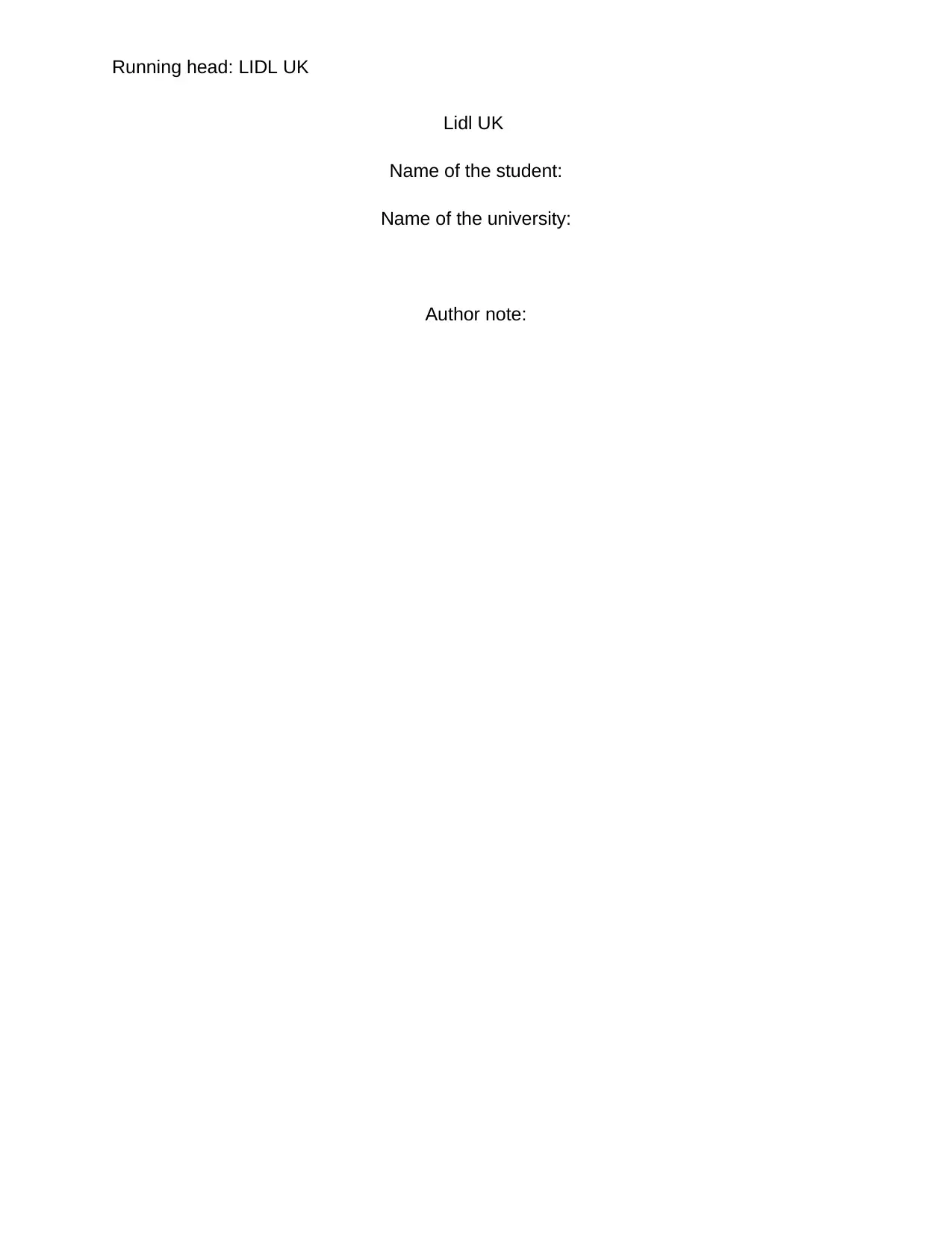
Running head: LIDL UK
Lidl UK
Name of the student:
Name of the university:
Author note:
Lidl UK
Name of the student:
Name of the university:
Author note:
Paraphrase This Document
Need a fresh take? Get an instant paraphrase of this document with our AI Paraphraser
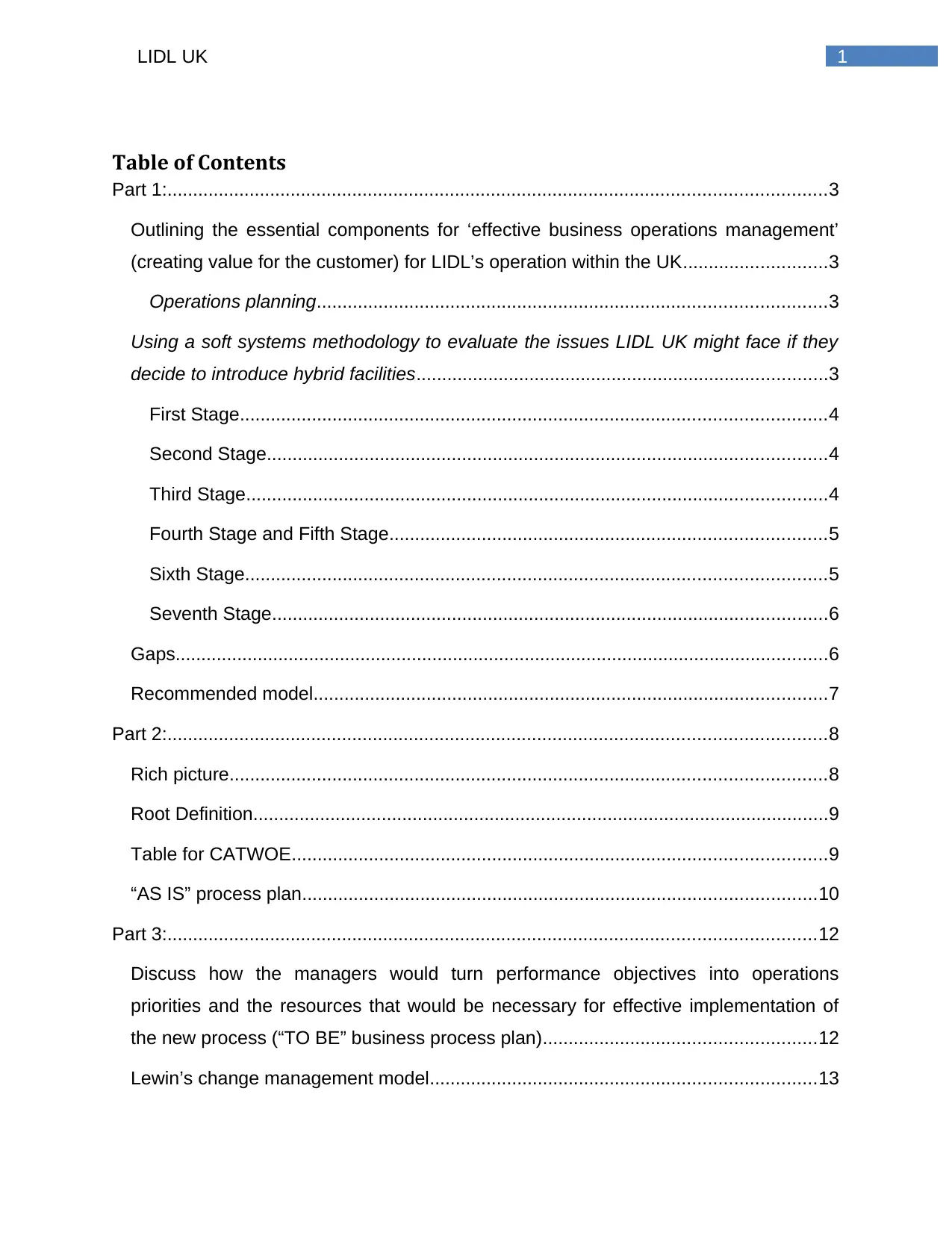
1LIDL UK
Table of Contents
Part 1:................................................................................................................................3
Outlining the essential components for ‘effective business operations management’
(creating value for the customer) for LIDL’s operation within the UK............................3
Operations planning...................................................................................................3
Using a soft systems methodology to evaluate the issues LIDL UK might face if they
decide to introduce hybrid facilities................................................................................3
First Stage..................................................................................................................4
Second Stage.............................................................................................................4
Third Stage.................................................................................................................4
Fourth Stage and Fifth Stage.....................................................................................5
Sixth Stage.................................................................................................................5
Seventh Stage............................................................................................................6
Gaps...............................................................................................................................6
Recommended model....................................................................................................7
Part 2:................................................................................................................................8
Rich picture....................................................................................................................8
Root Definition................................................................................................................9
Table for CATWOE........................................................................................................9
“AS IS” process plan....................................................................................................10
Part 3:..............................................................................................................................12
Discuss how the managers would turn performance objectives into operations
priorities and the resources that would be necessary for effective implementation of
the new process (“TO BE” business process plan).....................................................12
Lewin’s change management model...........................................................................13
Table of Contents
Part 1:................................................................................................................................3
Outlining the essential components for ‘effective business operations management’
(creating value for the customer) for LIDL’s operation within the UK............................3
Operations planning...................................................................................................3
Using a soft systems methodology to evaluate the issues LIDL UK might face if they
decide to introduce hybrid facilities................................................................................3
First Stage..................................................................................................................4
Second Stage.............................................................................................................4
Third Stage.................................................................................................................4
Fourth Stage and Fifth Stage.....................................................................................5
Sixth Stage.................................................................................................................5
Seventh Stage............................................................................................................6
Gaps...............................................................................................................................6
Recommended model....................................................................................................7
Part 2:................................................................................................................................8
Rich picture....................................................................................................................8
Root Definition................................................................................................................9
Table for CATWOE........................................................................................................9
“AS IS” process plan....................................................................................................10
Part 3:..............................................................................................................................12
Discuss how the managers would turn performance objectives into operations
priorities and the resources that would be necessary for effective implementation of
the new process (“TO BE” business process plan).....................................................12
Lewin’s change management model...........................................................................13
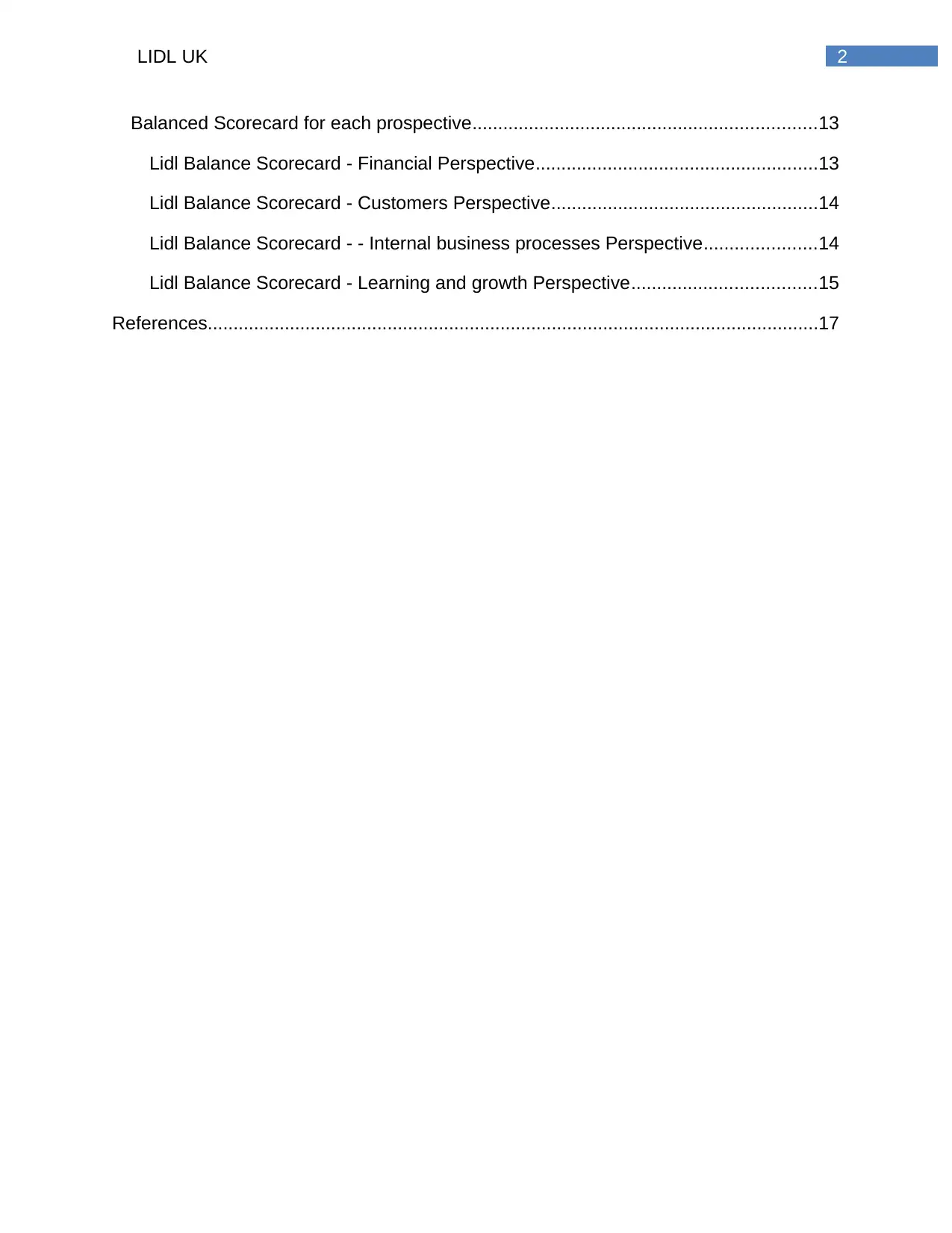
2LIDL UK
Balanced Scorecard for each prospective...................................................................13
Lidl Balance Scorecard - Financial Perspective.......................................................13
Lidl Balance Scorecard - Customers Perspective....................................................14
Lidl Balance Scorecard - - Internal business processes Perspective......................14
Lidl Balance Scorecard - Learning and growth Perspective....................................15
References.......................................................................................................................17
Balanced Scorecard for each prospective...................................................................13
Lidl Balance Scorecard - Financial Perspective.......................................................13
Lidl Balance Scorecard - Customers Perspective....................................................14
Lidl Balance Scorecard - - Internal business processes Perspective......................14
Lidl Balance Scorecard - Learning and growth Perspective....................................15
References.......................................................................................................................17
⊘ This is a preview!⊘
Do you want full access?
Subscribe today to unlock all pages.

Trusted by 1+ million students worldwide
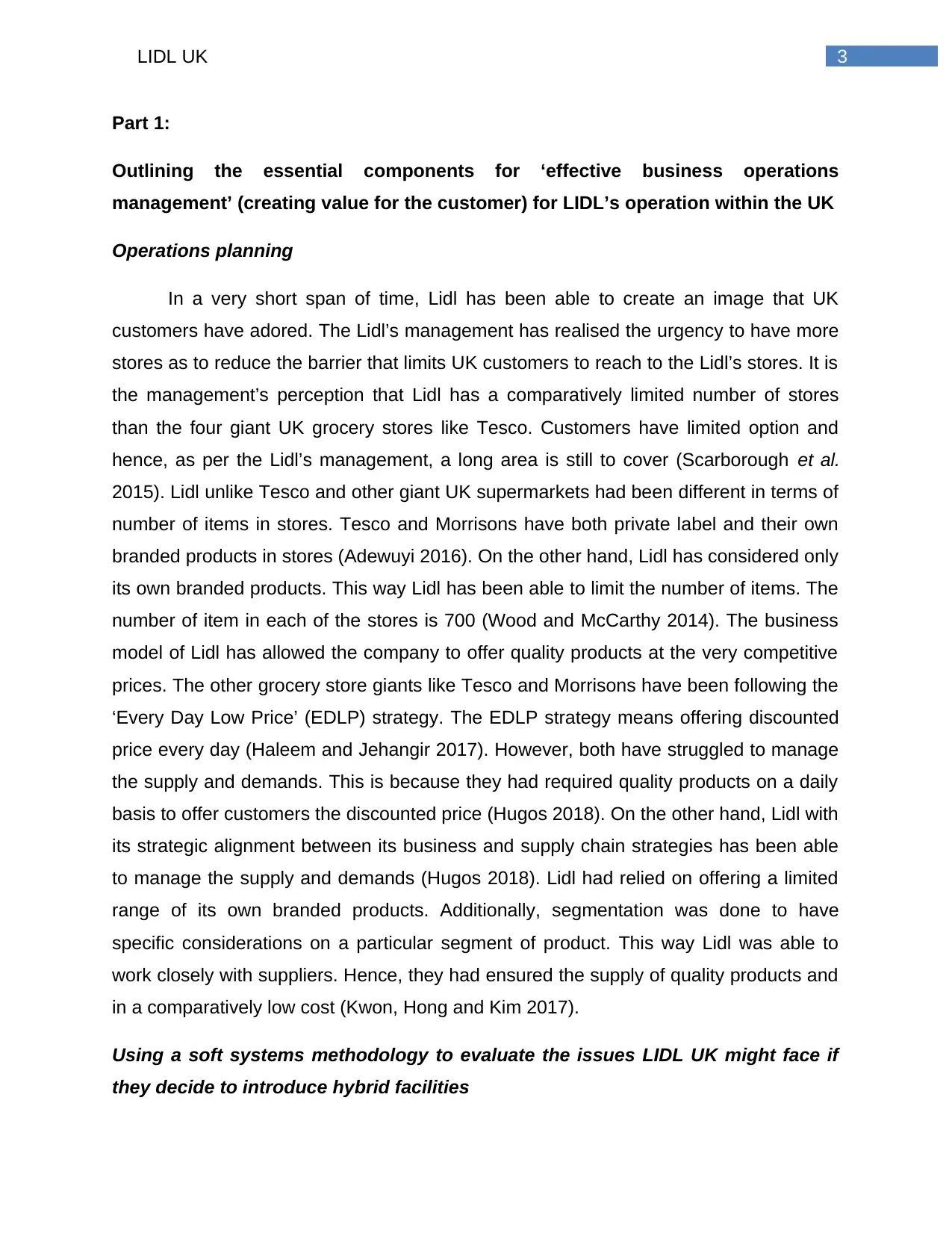
3LIDL UK
Part 1:
Outlining the essential components for ‘effective business operations
management’ (creating value for the customer) for LIDL’s operation within the UK
Operations planning
In a very short span of time, Lidl has been able to create an image that UK
customers have adored. The Lidl’s management has realised the urgency to have more
stores as to reduce the barrier that limits UK customers to reach to the Lidl’s stores. It is
the management’s perception that Lidl has a comparatively limited number of stores
than the four giant UK grocery stores like Tesco. Customers have limited option and
hence, as per the Lidl’s management, a long area is still to cover (Scarborough et al.
2015). Lidl unlike Tesco and other giant UK supermarkets had been different in terms of
number of items in stores. Tesco and Morrisons have both private label and their own
branded products in stores (Adewuyi 2016). On the other hand, Lidl has considered only
its own branded products. This way Lidl has been able to limit the number of items. The
number of item in each of the stores is 700 (Wood and McCarthy 2014). The business
model of Lidl has allowed the company to offer quality products at the very competitive
prices. The other grocery store giants like Tesco and Morrisons have been following the
‘Every Day Low Price’ (EDLP) strategy. The EDLP strategy means offering discounted
price every day (Haleem and Jehangir 2017). However, both have struggled to manage
the supply and demands. This is because they had required quality products on a daily
basis to offer customers the discounted price (Hugos 2018). On the other hand, Lidl with
its strategic alignment between its business and supply chain strategies has been able
to manage the supply and demands (Hugos 2018). Lidl had relied on offering a limited
range of its own branded products. Additionally, segmentation was done to have
specific considerations on a particular segment of product. This way Lidl was able to
work closely with suppliers. Hence, they had ensured the supply of quality products and
in a comparatively low cost (Kwon, Hong and Kim 2017).
Using a soft systems methodology to evaluate the issues LIDL UK might face if
they decide to introduce hybrid facilities
Part 1:
Outlining the essential components for ‘effective business operations
management’ (creating value for the customer) for LIDL’s operation within the UK
Operations planning
In a very short span of time, Lidl has been able to create an image that UK
customers have adored. The Lidl’s management has realised the urgency to have more
stores as to reduce the barrier that limits UK customers to reach to the Lidl’s stores. It is
the management’s perception that Lidl has a comparatively limited number of stores
than the four giant UK grocery stores like Tesco. Customers have limited option and
hence, as per the Lidl’s management, a long area is still to cover (Scarborough et al.
2015). Lidl unlike Tesco and other giant UK supermarkets had been different in terms of
number of items in stores. Tesco and Morrisons have both private label and their own
branded products in stores (Adewuyi 2016). On the other hand, Lidl has considered only
its own branded products. This way Lidl has been able to limit the number of items. The
number of item in each of the stores is 700 (Wood and McCarthy 2014). The business
model of Lidl has allowed the company to offer quality products at the very competitive
prices. The other grocery store giants like Tesco and Morrisons have been following the
‘Every Day Low Price’ (EDLP) strategy. The EDLP strategy means offering discounted
price every day (Haleem and Jehangir 2017). However, both have struggled to manage
the supply and demands. This is because they had required quality products on a daily
basis to offer customers the discounted price (Hugos 2018). On the other hand, Lidl with
its strategic alignment between its business and supply chain strategies has been able
to manage the supply and demands (Hugos 2018). Lidl had relied on offering a limited
range of its own branded products. Additionally, segmentation was done to have
specific considerations on a particular segment of product. This way Lidl was able to
work closely with suppliers. Hence, they had ensured the supply of quality products and
in a comparatively low cost (Kwon, Hong and Kim 2017).
Using a soft systems methodology to evaluate the issues LIDL UK might face if
they decide to introduce hybrid facilities
Paraphrase This Document
Need a fresh take? Get an instant paraphrase of this document with our AI Paraphraser
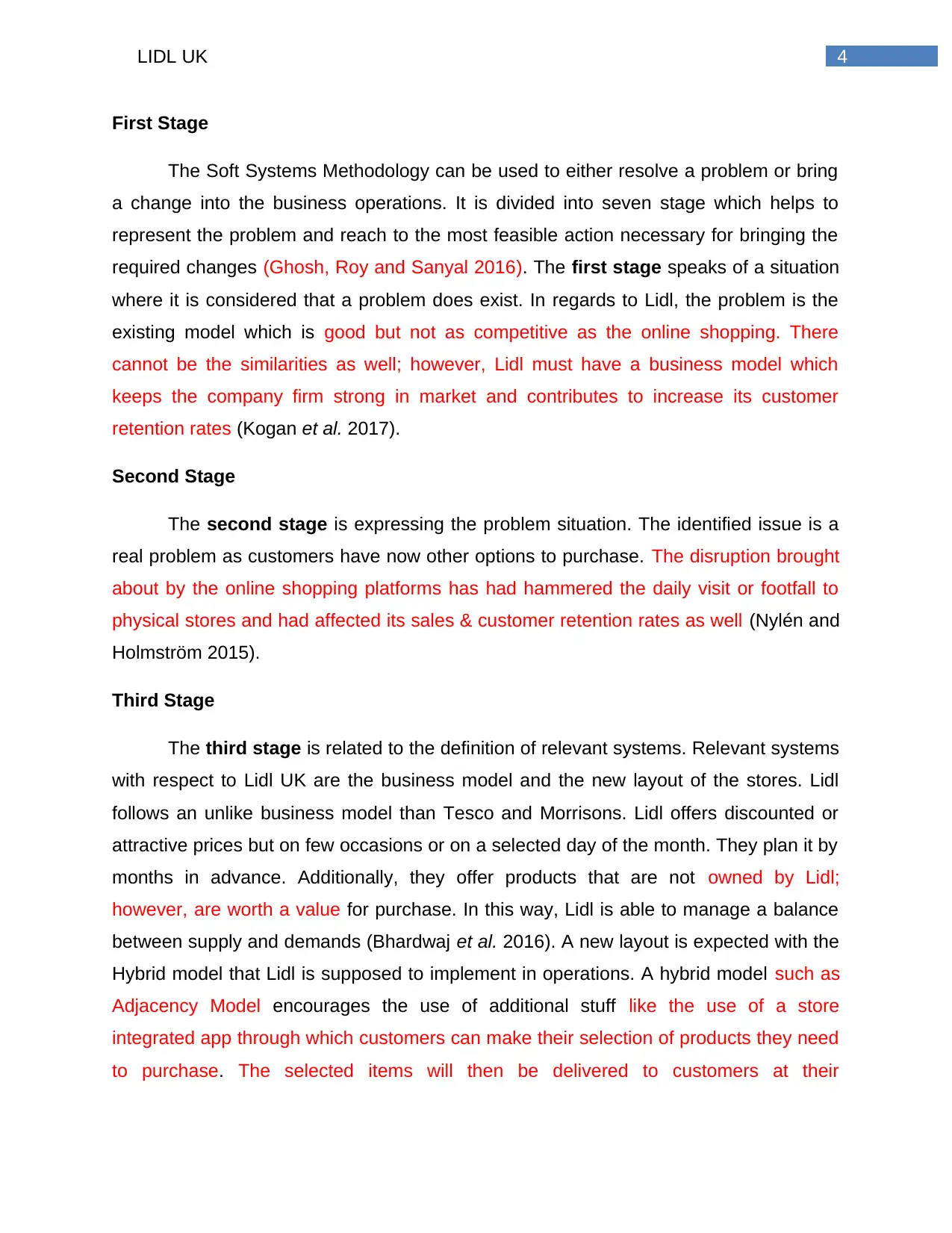
4LIDL UK
First Stage
The Soft Systems Methodology can be used to either resolve a problem or bring
a change into the business operations. It is divided into seven stage which helps to
represent the problem and reach to the most feasible action necessary for bringing the
required changes (Ghosh, Roy and Sanyal 2016). The first stage speaks of a situation
where it is considered that a problem does exist. In regards to Lidl, the problem is the
existing model which is good but not as competitive as the online shopping. There
cannot be the similarities as well; however, Lidl must have a business model which
keeps the company firm strong in market and contributes to increase its customer
retention rates (Kogan et al. 2017).
Second Stage
The second stage is expressing the problem situation. The identified issue is a
real problem as customers have now other options to purchase. The disruption brought
about by the online shopping platforms has had hammered the daily visit or footfall to
physical stores and had affected its sales & customer retention rates as well (Nylén and
Holmström 2015).
Third Stage
The third stage is related to the definition of relevant systems. Relevant systems
with respect to Lidl UK are the business model and the new layout of the stores. Lidl
follows an unlike business model than Tesco and Morrisons. Lidl offers discounted or
attractive prices but on few occasions or on a selected day of the month. They plan it by
months in advance. Additionally, they offer products that are not owned by Lidl;
however, are worth a value for purchase. In this way, Lidl is able to manage a balance
between supply and demands (Bhardwaj et al. 2016). A new layout is expected with the
Hybrid model that Lidl is supposed to implement in operations. A hybrid model such as
Adjacency Model encourages the use of additional stuff like the use of a store
integrated app through which customers can make their selection of products they need
to purchase. The selected items will then be delivered to customers at their
First Stage
The Soft Systems Methodology can be used to either resolve a problem or bring
a change into the business operations. It is divided into seven stage which helps to
represent the problem and reach to the most feasible action necessary for bringing the
required changes (Ghosh, Roy and Sanyal 2016). The first stage speaks of a situation
where it is considered that a problem does exist. In regards to Lidl, the problem is the
existing model which is good but not as competitive as the online shopping. There
cannot be the similarities as well; however, Lidl must have a business model which
keeps the company firm strong in market and contributes to increase its customer
retention rates (Kogan et al. 2017).
Second Stage
The second stage is expressing the problem situation. The identified issue is a
real problem as customers have now other options to purchase. The disruption brought
about by the online shopping platforms has had hammered the daily visit or footfall to
physical stores and had affected its sales & customer retention rates as well (Nylén and
Holmström 2015).
Third Stage
The third stage is related to the definition of relevant systems. Relevant systems
with respect to Lidl UK are the business model and the new layout of the stores. Lidl
follows an unlike business model than Tesco and Morrisons. Lidl offers discounted or
attractive prices but on few occasions or on a selected day of the month. They plan it by
months in advance. Additionally, they offer products that are not owned by Lidl;
however, are worth a value for purchase. In this way, Lidl is able to manage a balance
between supply and demands (Bhardwaj et al. 2016). A new layout is expected with the
Hybrid model that Lidl is supposed to implement in operations. A hybrid model such as
Adjacency Model encourages the use of additional stuff like the use of a store
integrated app through which customers can make their selection of products they need
to purchase. The selected items will then be delivered to customers at their
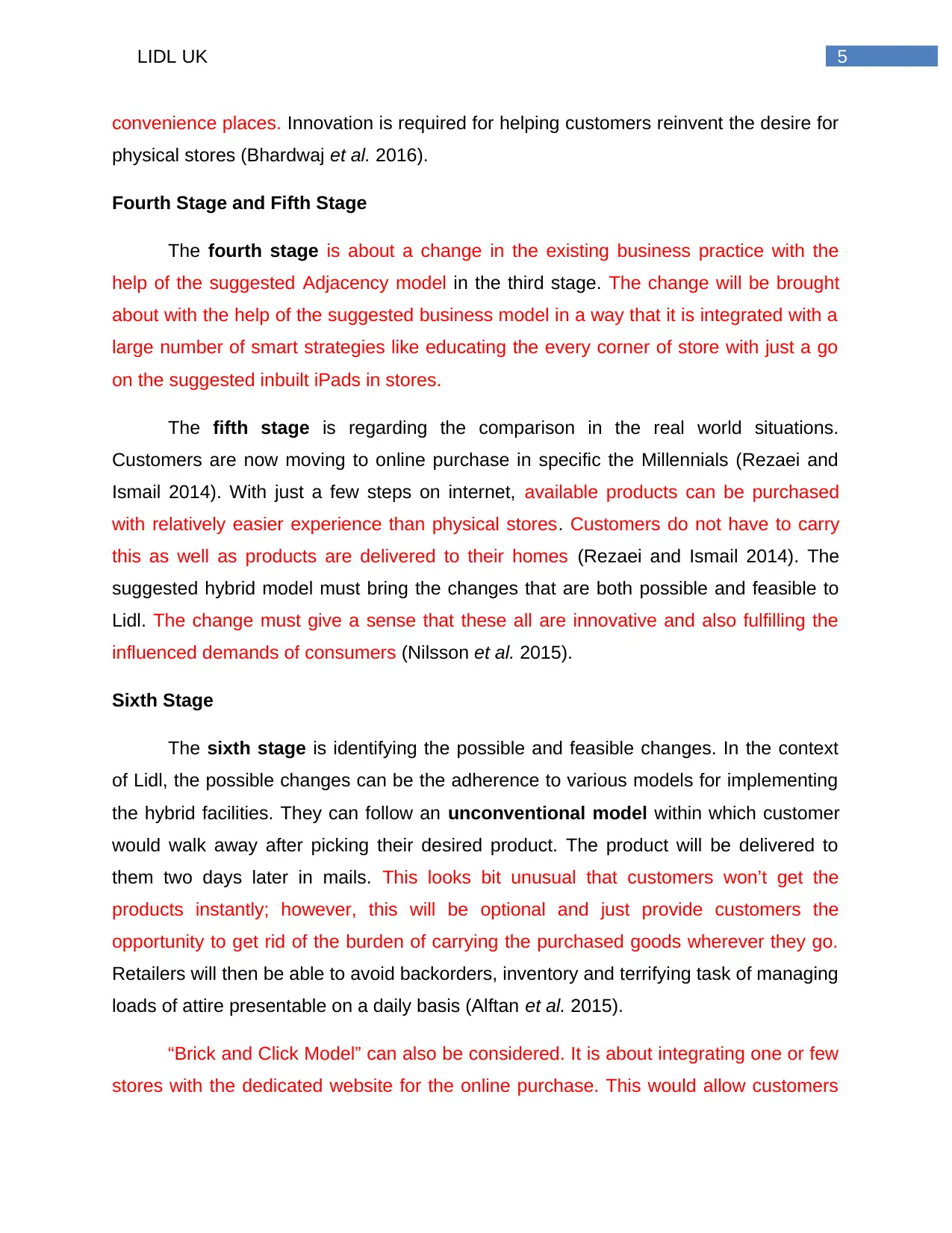
5LIDL UK
convenience places. Innovation is required for helping customers reinvent the desire for
physical stores (Bhardwaj et al. 2016).
Fourth Stage and Fifth Stage
The fourth stage is about a change in the existing business practice with the
help of the suggested Adjacency model in the third stage. The change will be brought
about with the help of the suggested business model in a way that it is integrated with a
large number of smart strategies like educating the every corner of store with just a go
on the suggested inbuilt iPads in stores.
The fifth stage is regarding the comparison in the real world situations.
Customers are now moving to online purchase in specific the Millennials (Rezaei and
Ismail 2014). With just a few steps on internet, available products can be purchased
with relatively easier experience than physical stores. Customers do not have to carry
this as well as products are delivered to their homes (Rezaei and Ismail 2014). The
suggested hybrid model must bring the changes that are both possible and feasible to
Lidl. The change must give a sense that these all are innovative and also fulfilling the
influenced demands of consumers (Nilsson et al. 2015).
Sixth Stage
The sixth stage is identifying the possible and feasible changes. In the context
of Lidl, the possible changes can be the adherence to various models for implementing
the hybrid facilities. They can follow an unconventional model within which customer
would walk away after picking their desired product. The product will be delivered to
them two days later in mails. This looks bit unusual that customers won’t get the
products instantly; however, this will be optional and just provide customers the
opportunity to get rid of the burden of carrying the purchased goods wherever they go.
Retailers will then be able to avoid backorders, inventory and terrifying task of managing
loads of attire presentable on a daily basis (Alftan et al. 2015).
“Brick and Click Model” can also be considered. It is about integrating one or few
stores with the dedicated website for the online purchase. This would allow customers
convenience places. Innovation is required for helping customers reinvent the desire for
physical stores (Bhardwaj et al. 2016).
Fourth Stage and Fifth Stage
The fourth stage is about a change in the existing business practice with the
help of the suggested Adjacency model in the third stage. The change will be brought
about with the help of the suggested business model in a way that it is integrated with a
large number of smart strategies like educating the every corner of store with just a go
on the suggested inbuilt iPads in stores.
The fifth stage is regarding the comparison in the real world situations.
Customers are now moving to online purchase in specific the Millennials (Rezaei and
Ismail 2014). With just a few steps on internet, available products can be purchased
with relatively easier experience than physical stores. Customers do not have to carry
this as well as products are delivered to their homes (Rezaei and Ismail 2014). The
suggested hybrid model must bring the changes that are both possible and feasible to
Lidl. The change must give a sense that these all are innovative and also fulfilling the
influenced demands of consumers (Nilsson et al. 2015).
Sixth Stage
The sixth stage is identifying the possible and feasible changes. In the context
of Lidl, the possible changes can be the adherence to various models for implementing
the hybrid facilities. They can follow an unconventional model within which customer
would walk away after picking their desired product. The product will be delivered to
them two days later in mails. This looks bit unusual that customers won’t get the
products instantly; however, this will be optional and just provide customers the
opportunity to get rid of the burden of carrying the purchased goods wherever they go.
Retailers will then be able to avoid backorders, inventory and terrifying task of managing
loads of attire presentable on a daily basis (Alftan et al. 2015).
“Brick and Click Model” can also be considered. It is about integrating one or few
stores with the dedicated website for the online purchase. This would allow customers
⊘ This is a preview!⊘
Do you want full access?
Subscribe today to unlock all pages.

Trusted by 1+ million students worldwide
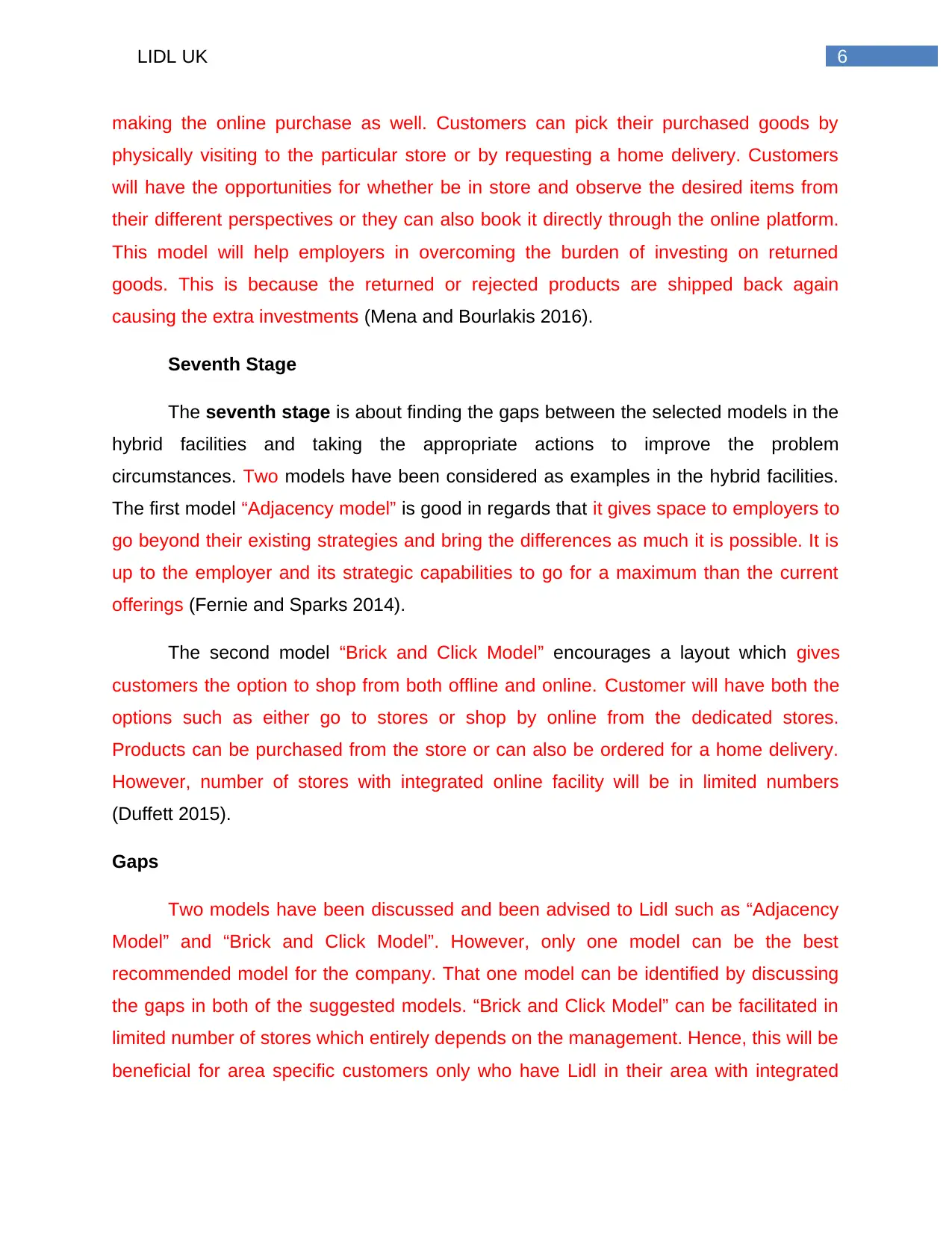
6LIDL UK
making the online purchase as well. Customers can pick their purchased goods by
physically visiting to the particular store or by requesting a home delivery. Customers
will have the opportunities for whether be in store and observe the desired items from
their different perspectives or they can also book it directly through the online platform.
This model will help employers in overcoming the burden of investing on returned
goods. This is because the returned or rejected products are shipped back again
causing the extra investments (Mena and Bourlakis 2016).
Seventh Stage
The seventh stage is about finding the gaps between the selected models in the
hybrid facilities and taking the appropriate actions to improve the problem
circumstances. Two models have been considered as examples in the hybrid facilities.
The first model “Adjacency model” is good in regards that it gives space to employers to
go beyond their existing strategies and bring the differences as much it is possible. It is
up to the employer and its strategic capabilities to go for a maximum than the current
offerings (Fernie and Sparks 2014).
The second model “Brick and Click Model” encourages a layout which gives
customers the option to shop from both offline and online. Customer will have both the
options such as either go to stores or shop by online from the dedicated stores.
Products can be purchased from the store or can also be ordered for a home delivery.
However, number of stores with integrated online facility will be in limited numbers
(Duffett 2015).
Gaps
Two models have been discussed and been advised to Lidl such as “Adjacency
Model” and “Brick and Click Model”. However, only one model can be the best
recommended model for the company. That one model can be identified by discussing
the gaps in both of the suggested models. “Brick and Click Model” can be facilitated in
limited number of stores which entirely depends on the management. Hence, this will be
beneficial for area specific customers only who have Lidl in their area with integrated
making the online purchase as well. Customers can pick their purchased goods by
physically visiting to the particular store or by requesting a home delivery. Customers
will have the opportunities for whether be in store and observe the desired items from
their different perspectives or they can also book it directly through the online platform.
This model will help employers in overcoming the burden of investing on returned
goods. This is because the returned or rejected products are shipped back again
causing the extra investments (Mena and Bourlakis 2016).
Seventh Stage
The seventh stage is about finding the gaps between the selected models in the
hybrid facilities and taking the appropriate actions to improve the problem
circumstances. Two models have been considered as examples in the hybrid facilities.
The first model “Adjacency model” is good in regards that it gives space to employers to
go beyond their existing strategies and bring the differences as much it is possible. It is
up to the employer and its strategic capabilities to go for a maximum than the current
offerings (Fernie and Sparks 2014).
The second model “Brick and Click Model” encourages a layout which gives
customers the option to shop from both offline and online. Customer will have both the
options such as either go to stores or shop by online from the dedicated stores.
Products can be purchased from the store or can also be ordered for a home delivery.
However, number of stores with integrated online facility will be in limited numbers
(Duffett 2015).
Gaps
Two models have been discussed and been advised to Lidl such as “Adjacency
Model” and “Brick and Click Model”. However, only one model can be the best
recommended model for the company. That one model can be identified by discussing
the gaps in both of the suggested models. “Brick and Click Model” can be facilitated in
limited number of stores which entirely depends on the management. Hence, this will be
beneficial for area specific customers only who have Lidl in their area with integrated
Paraphrase This Document
Need a fresh take? Get an instant paraphrase of this document with our AI Paraphraser
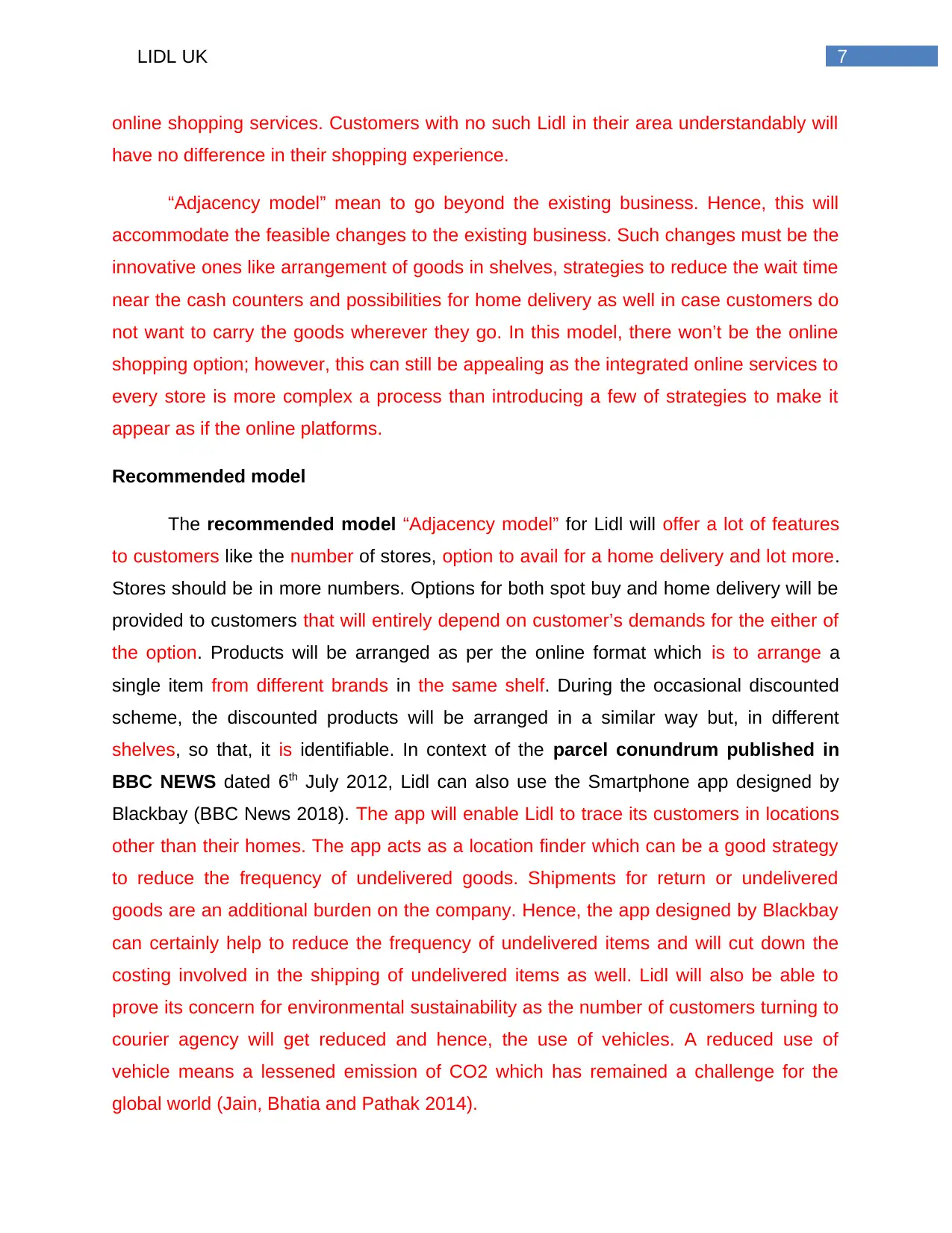
7LIDL UK
online shopping services. Customers with no such Lidl in their area understandably will
have no difference in their shopping experience.
“Adjacency model” mean to go beyond the existing business. Hence, this will
accommodate the feasible changes to the existing business. Such changes must be the
innovative ones like arrangement of goods in shelves, strategies to reduce the wait time
near the cash counters and possibilities for home delivery as well in case customers do
not want to carry the goods wherever they go. In this model, there won’t be the online
shopping option; however, this can still be appealing as the integrated online services to
every store is more complex a process than introducing a few of strategies to make it
appear as if the online platforms.
Recommended model
The recommended model “Adjacency model” for Lidl will offer a lot of features
to customers like the number of stores, option to avail for a home delivery and lot more.
Stores should be in more numbers. Options for both spot buy and home delivery will be
provided to customers that will entirely depend on customer’s demands for the either of
the option. Products will be arranged as per the online format which is to arrange a
single item from different brands in the same shelf. During the occasional discounted
scheme, the discounted products will be arranged in a similar way but, in different
shelves, so that, it is identifiable. In context of the parcel conundrum published in
BBC NEWS dated 6th July 2012, Lidl can also use the Smartphone app designed by
Blackbay (BBC News 2018). The app will enable Lidl to trace its customers in locations
other than their homes. The app acts as a location finder which can be a good strategy
to reduce the frequency of undelivered goods. Shipments for return or undelivered
goods are an additional burden on the company. Hence, the app designed by Blackbay
can certainly help to reduce the frequency of undelivered items and will cut down the
costing involved in the shipping of undelivered items as well. Lidl will also be able to
prove its concern for environmental sustainability as the number of customers turning to
courier agency will get reduced and hence, the use of vehicles. A reduced use of
vehicle means a lessened emission of CO2 which has remained a challenge for the
global world (Jain, Bhatia and Pathak 2014).
online shopping services. Customers with no such Lidl in their area understandably will
have no difference in their shopping experience.
“Adjacency model” mean to go beyond the existing business. Hence, this will
accommodate the feasible changes to the existing business. Such changes must be the
innovative ones like arrangement of goods in shelves, strategies to reduce the wait time
near the cash counters and possibilities for home delivery as well in case customers do
not want to carry the goods wherever they go. In this model, there won’t be the online
shopping option; however, this can still be appealing as the integrated online services to
every store is more complex a process than introducing a few of strategies to make it
appear as if the online platforms.
Recommended model
The recommended model “Adjacency model” for Lidl will offer a lot of features
to customers like the number of stores, option to avail for a home delivery and lot more.
Stores should be in more numbers. Options for both spot buy and home delivery will be
provided to customers that will entirely depend on customer’s demands for the either of
the option. Products will be arranged as per the online format which is to arrange a
single item from different brands in the same shelf. During the occasional discounted
scheme, the discounted products will be arranged in a similar way but, in different
shelves, so that, it is identifiable. In context of the parcel conundrum published in
BBC NEWS dated 6th July 2012, Lidl can also use the Smartphone app designed by
Blackbay (BBC News 2018). The app will enable Lidl to trace its customers in locations
other than their homes. The app acts as a location finder which can be a good strategy
to reduce the frequency of undelivered goods. Shipments for return or undelivered
goods are an additional burden on the company. Hence, the app designed by Blackbay
can certainly help to reduce the frequency of undelivered items and will cut down the
costing involved in the shipping of undelivered items as well. Lidl will also be able to
prove its concern for environmental sustainability as the number of customers turning to
courier agency will get reduced and hence, the use of vehicles. A reduced use of
vehicle means a lessened emission of CO2 which has remained a challenge for the
global world (Jain, Bhatia and Pathak 2014).
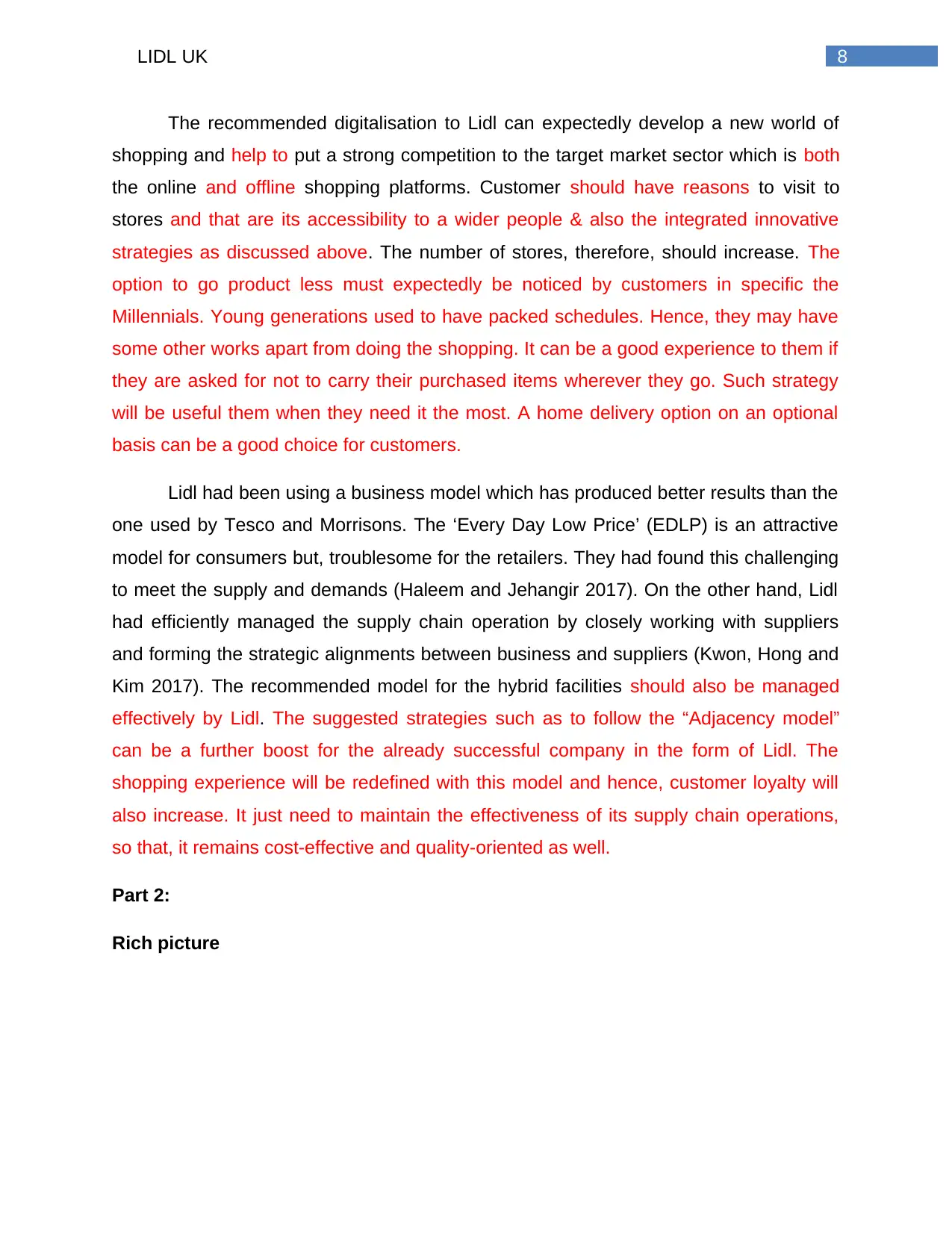
8LIDL UK
The recommended digitalisation to Lidl can expectedly develop a new world of
shopping and help to put a strong competition to the target market sector which is both
the online and offline shopping platforms. Customer should have reasons to visit to
stores and that are its accessibility to a wider people & also the integrated innovative
strategies as discussed above. The number of stores, therefore, should increase. The
option to go product less must expectedly be noticed by customers in specific the
Millennials. Young generations used to have packed schedules. Hence, they may have
some other works apart from doing the shopping. It can be a good experience to them if
they are asked for not to carry their purchased items wherever they go. Such strategy
will be useful them when they need it the most. A home delivery option on an optional
basis can be a good choice for customers.
Lidl had been using a business model which has produced better results than the
one used by Tesco and Morrisons. The ‘Every Day Low Price’ (EDLP) is an attractive
model for consumers but, troublesome for the retailers. They had found this challenging
to meet the supply and demands (Haleem and Jehangir 2017). On the other hand, Lidl
had efficiently managed the supply chain operation by closely working with suppliers
and forming the strategic alignments between business and suppliers (Kwon, Hong and
Kim 2017). The recommended model for the hybrid facilities should also be managed
effectively by Lidl. The suggested strategies such as to follow the “Adjacency model”
can be a further boost for the already successful company in the form of Lidl. The
shopping experience will be redefined with this model and hence, customer loyalty will
also increase. It just need to maintain the effectiveness of its supply chain operations,
so that, it remains cost-effective and quality-oriented as well.
Part 2:
Rich picture
The recommended digitalisation to Lidl can expectedly develop a new world of
shopping and help to put a strong competition to the target market sector which is both
the online and offline shopping platforms. Customer should have reasons to visit to
stores and that are its accessibility to a wider people & also the integrated innovative
strategies as discussed above. The number of stores, therefore, should increase. The
option to go product less must expectedly be noticed by customers in specific the
Millennials. Young generations used to have packed schedules. Hence, they may have
some other works apart from doing the shopping. It can be a good experience to them if
they are asked for not to carry their purchased items wherever they go. Such strategy
will be useful them when they need it the most. A home delivery option on an optional
basis can be a good choice for customers.
Lidl had been using a business model which has produced better results than the
one used by Tesco and Morrisons. The ‘Every Day Low Price’ (EDLP) is an attractive
model for consumers but, troublesome for the retailers. They had found this challenging
to meet the supply and demands (Haleem and Jehangir 2017). On the other hand, Lidl
had efficiently managed the supply chain operation by closely working with suppliers
and forming the strategic alignments between business and suppliers (Kwon, Hong and
Kim 2017). The recommended model for the hybrid facilities should also be managed
effectively by Lidl. The suggested strategies such as to follow the “Adjacency model”
can be a further boost for the already successful company in the form of Lidl. The
shopping experience will be redefined with this model and hence, customer loyalty will
also increase. It just need to maintain the effectiveness of its supply chain operations,
so that, it remains cost-effective and quality-oriented as well.
Part 2:
Rich picture
⊘ This is a preview!⊘
Do you want full access?
Subscribe today to unlock all pages.

Trusted by 1+ million students worldwide
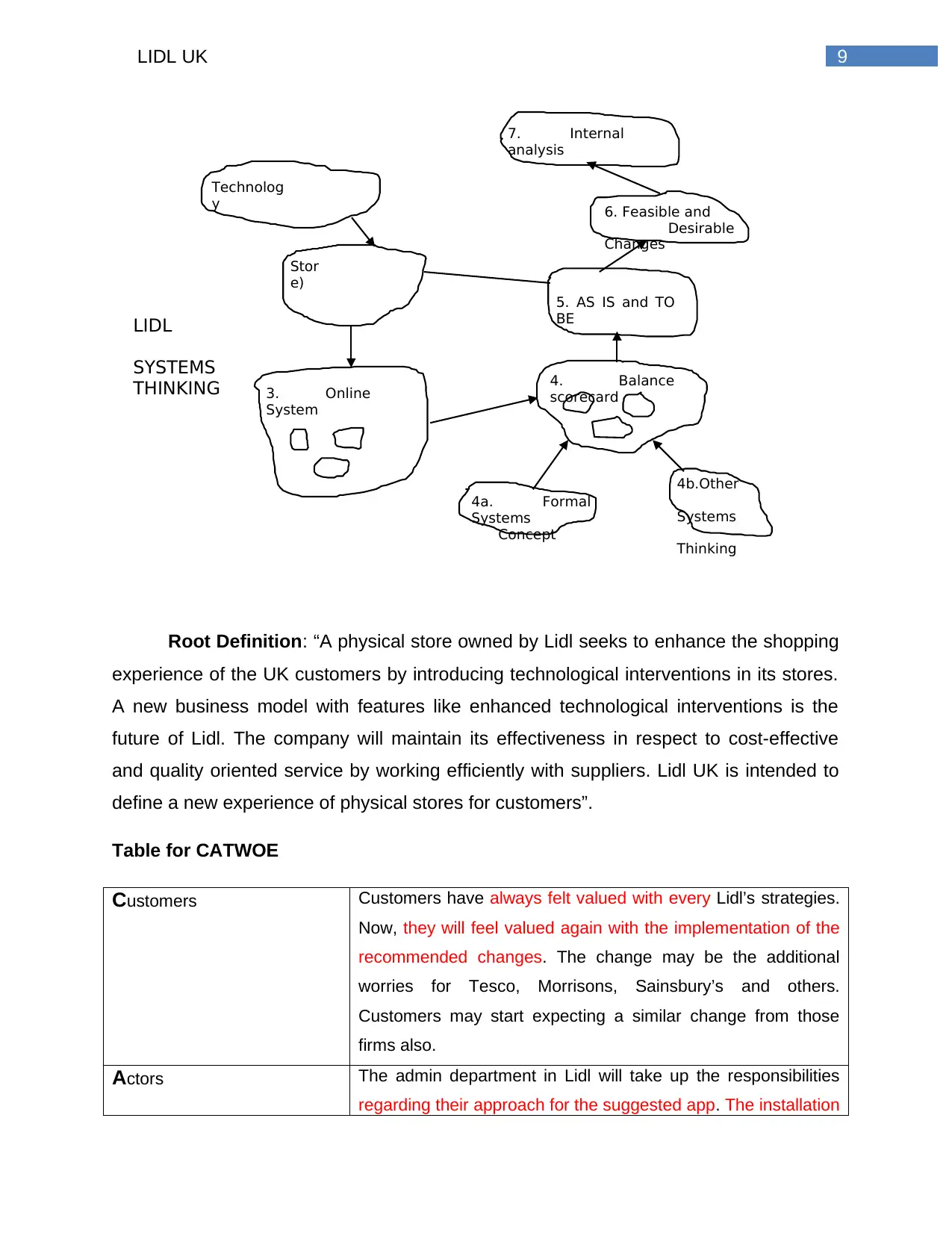
9LIDL UK
LIDL
SYSTEMS
THINKING
Technolog
y
Stor
e)
7. Internal
analysis
6. Feasible and
Desirable
Changes
5. AS IS and TO
BE
4. Balance
scorecard3. Online
System
4a. Formal
Systems
Concept
4b.Other
Systems
Thinking
Root Definition: “A physical store owned by Lidl seeks to enhance the shopping
experience of the UK customers by introducing technological interventions in its stores.
A new business model with features like enhanced technological interventions is the
future of Lidl. The company will maintain its effectiveness in respect to cost-effective
and quality oriented service by working efficiently with suppliers. Lidl UK is intended to
define a new experience of physical stores for customers”.
Table for CATWOE
Customers Customers have always felt valued with every Lidl’s strategies.
Now, they will feel valued again with the implementation of the
recommended changes. The change may be the additional
worries for Tesco, Morrisons, Sainsbury’s and others.
Customers may start expecting a similar change from those
firms also.
Actors The admin department in Lidl will take up the responsibilities
regarding their approach for the suggested app. The installation
LIDL
SYSTEMS
THINKING
Technolog
y
Stor
e)
7. Internal
analysis
6. Feasible and
Desirable
Changes
5. AS IS and TO
BE
4. Balance
scorecard3. Online
System
4a. Formal
Systems
Concept
4b.Other
Systems
Thinking
Root Definition: “A physical store owned by Lidl seeks to enhance the shopping
experience of the UK customers by introducing technological interventions in its stores.
A new business model with features like enhanced technological interventions is the
future of Lidl. The company will maintain its effectiveness in respect to cost-effective
and quality oriented service by working efficiently with suppliers. Lidl UK is intended to
define a new experience of physical stores for customers”.
Table for CATWOE
Customers Customers have always felt valued with every Lidl’s strategies.
Now, they will feel valued again with the implementation of the
recommended changes. The change may be the additional
worries for Tesco, Morrisons, Sainsbury’s and others.
Customers may start expecting a similar change from those
firms also.
Actors The admin department in Lidl will take up the responsibilities
regarding their approach for the suggested app. The installation
Paraphrase This Document
Need a fresh take? Get an instant paraphrase of this document with our AI Paraphraser
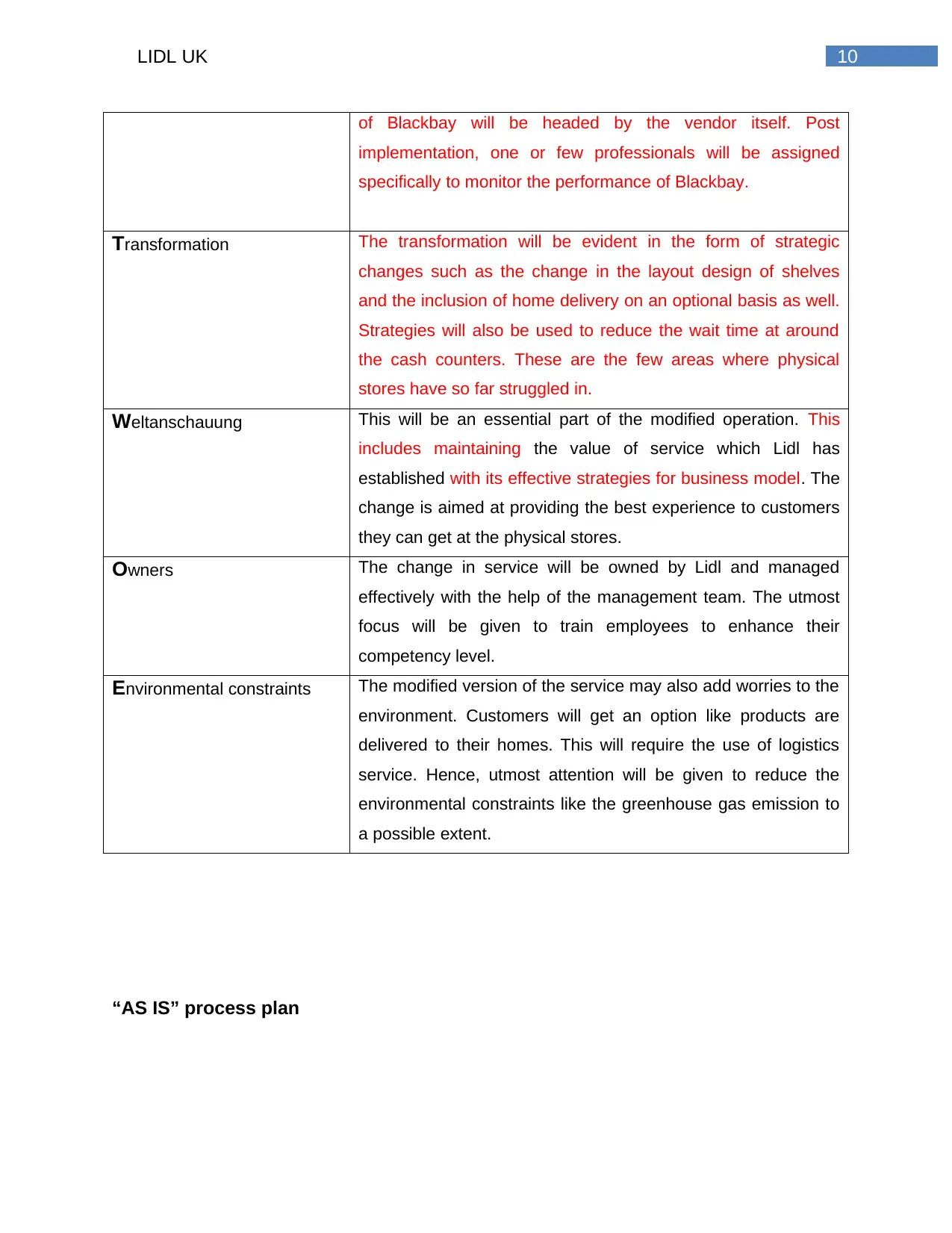
10LIDL UK
of Blackbay will be headed by the vendor itself. Post
implementation, one or few professionals will be assigned
specifically to monitor the performance of Blackbay.
Transformation The transformation will be evident in the form of strategic
changes such as the change in the layout design of shelves
and the inclusion of home delivery on an optional basis as well.
Strategies will also be used to reduce the wait time at around
the cash counters. These are the few areas where physical
stores have so far struggled in.
Weltanschauung This will be an essential part of the modified operation. This
includes maintaining the value of service which Lidl has
established with its effective strategies for business model. The
change is aimed at providing the best experience to customers
they can get at the physical stores.
Owners The change in service will be owned by Lidl and managed
effectively with the help of the management team. The utmost
focus will be given to train employees to enhance their
competency level.
Environmental constraints The modified version of the service may also add worries to the
environment. Customers will get an option like products are
delivered to their homes. This will require the use of logistics
service. Hence, utmost attention will be given to reduce the
environmental constraints like the greenhouse gas emission to
a possible extent.
“AS IS” process plan
of Blackbay will be headed by the vendor itself. Post
implementation, one or few professionals will be assigned
specifically to monitor the performance of Blackbay.
Transformation The transformation will be evident in the form of strategic
changes such as the change in the layout design of shelves
and the inclusion of home delivery on an optional basis as well.
Strategies will also be used to reduce the wait time at around
the cash counters. These are the few areas where physical
stores have so far struggled in.
Weltanschauung This will be an essential part of the modified operation. This
includes maintaining the value of service which Lidl has
established with its effective strategies for business model. The
change is aimed at providing the best experience to customers
they can get at the physical stores.
Owners The change in service will be owned by Lidl and managed
effectively with the help of the management team. The utmost
focus will be given to train employees to enhance their
competency level.
Environmental constraints The modified version of the service may also add worries to the
environment. Customers will get an option like products are
delivered to their homes. This will require the use of logistics
service. Hence, utmost attention will be given to reduce the
environmental constraints like the greenhouse gas emission to
a possible extent.
“AS IS” process plan
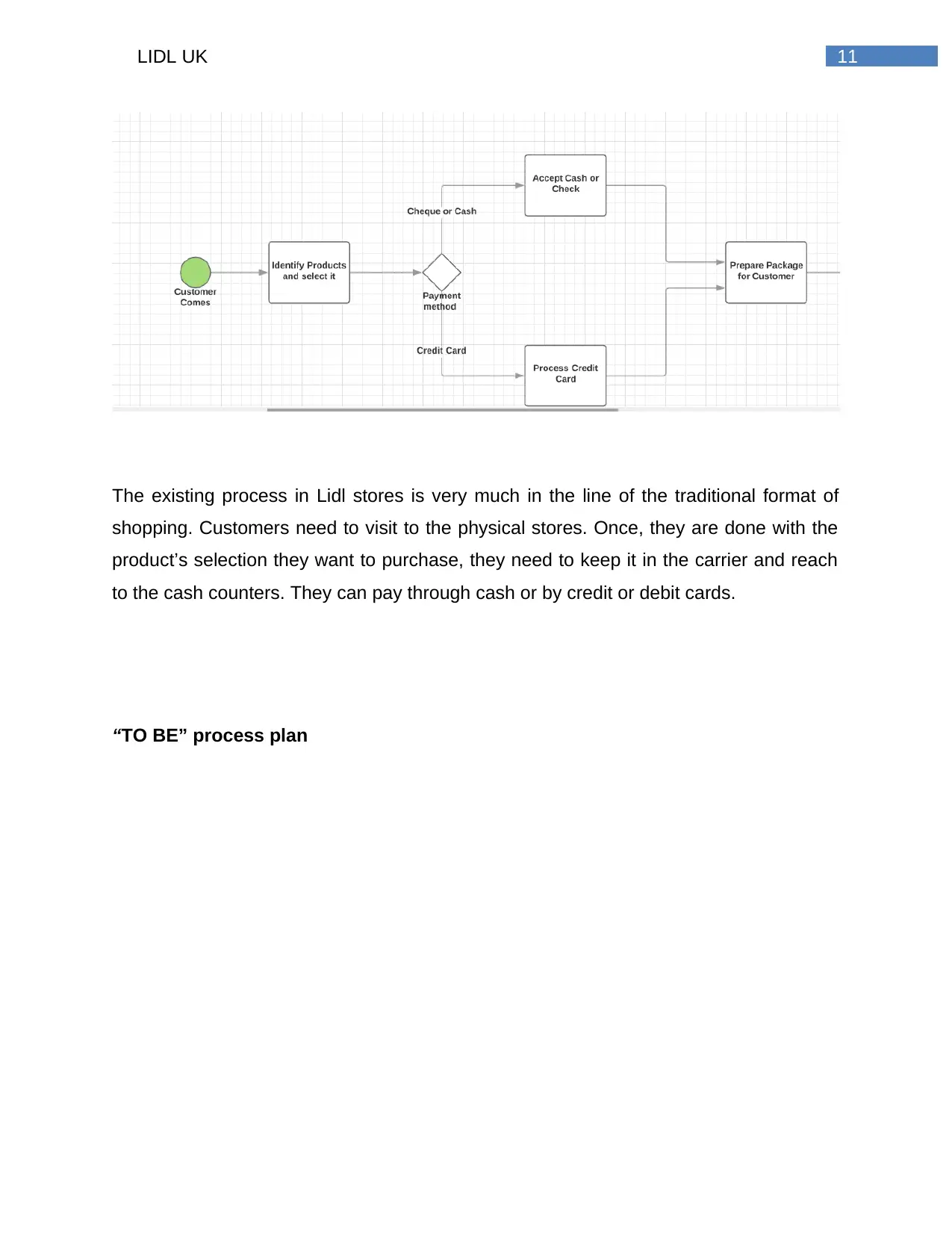
11LIDL UK
The existing process in Lidl stores is very much in the line of the traditional format of
shopping. Customers need to visit to the physical stores. Once, they are done with the
product’s selection they want to purchase, they need to keep it in the carrier and reach
to the cash counters. They can pay through cash or by credit or debit cards.
“TO BE” process plan
The existing process in Lidl stores is very much in the line of the traditional format of
shopping. Customers need to visit to the physical stores. Once, they are done with the
product’s selection they want to purchase, they need to keep it in the carrier and reach
to the cash counters. They can pay through cash or by credit or debit cards.
“TO BE” process plan
⊘ This is a preview!⊘
Do you want full access?
Subscribe today to unlock all pages.

Trusted by 1+ million students worldwide
1 out of 19
Related Documents
Your All-in-One AI-Powered Toolkit for Academic Success.
+13062052269
info@desklib.com
Available 24*7 on WhatsApp / Email
![[object Object]](/_next/static/media/star-bottom.7253800d.svg)
Unlock your academic potential
Copyright © 2020–2025 A2Z Services. All Rights Reserved. Developed and managed by ZUCOL.





